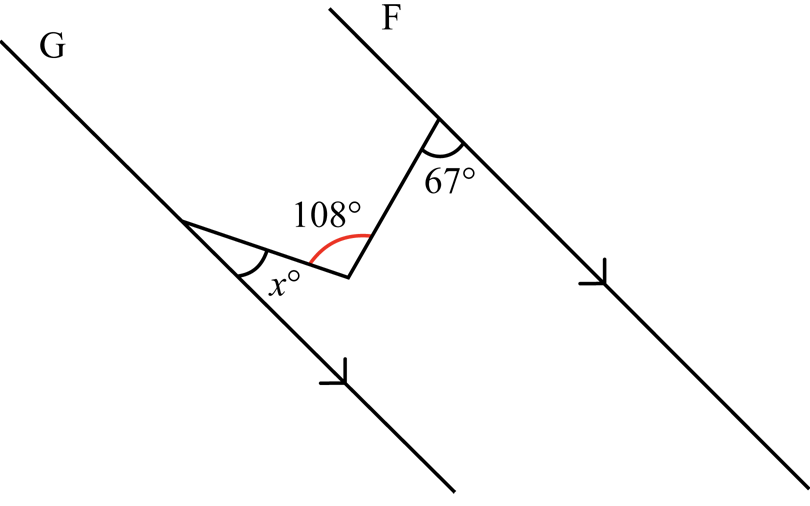In the diagram below, \(DG\) is parallel to \(BC\), and \(\angle ABC = 115^{\circ} \).
Find the value of \(x^{\circ}\), giving reasons for your answer. (2 marks)
--- 4 WORK AREA LINES (style=lined) ---
Aussie Maths & Science Teachers: Save your time with SmarterEd
In the diagram below, \(DG\) is parallel to \(BC\), and \(\angle ABC = 115^{\circ} \).
Find the value of \(x^{\circ}\), giving reasons for your answer. (2 marks)
--- 4 WORK AREA LINES (style=lined) ---
\(\angle CBE = 180-115=65^{\circ}\ \ \text{(180° in a straight line)}\)
\(x^{\circ} = 65^{\circ}\ \ \text{(alternate angles)}\)
\(\angle CBE = 180-115=65^{\circ}\ \ \text{(180° in a straight line)}\)
\(x^{\circ} = 65^{\circ}\ \ \text{(alternate angles)}\)
In the diagram below, \(PR\) is parallel to \(TU\) and reflex \(\angle QST = 255^{\circ}\)
Find the value of \(x^{\circ}\), giving reasons for your answer. (3 marks)
--- 6 WORK AREA LINES (style=lined) ---
\(\angle QST = 360-255 = 105^{\circ}\ \ \text{(360° about a point)}\)
\(\angle VSQ =70^{\circ} \ \ \text{(alternate angles)} \)
\(\angle VST\ =x^{\circ} \ \ \text{(alternate angles)} \)
| \(x^{\circ}\) | \(=105-70\) | |
| \(=35^{\circ}\) |
\(\text{Add middle parallel line:}\)
\(\angle QST = 360-255 = 105^{\circ}\ \ \text{(360° about a point)}\)
\(\angle VSQ =70^{\circ} \ \ \text{(alternate angles)} \)
\(\angle VST\ =x^{\circ} \ \ \text{(alternate angles)} \)
| \(x^{\circ}\) | \(=105-70 \) | |
| \(=35^{\circ}\) |
In the diagram below, find the value of \(x^{\circ}\), giving reasons for your answer. (2 marks)
--- 4 WORK AREA LINES (style=lined) ---
\(y^{\circ}\ =70^{\circ} \ \ \text{(alternate angles)} \)
\(x^{\circ}\ =z^{\circ} \ \ \text{(alternate angles)} \)
| \((z+y)^{\circ}\) | \(=110^{\circ}\ \) | |
| \((x+y)^{\circ}\) | \(=110^{\circ}\ \) | |
| \(x^{\circ}\) | \(=110-70\) | |
| \(=40^{\circ}\) |
\(\text{Extend middle parallel line:}\)
\(y^{\circ}\ =70^{\circ} \ \ \text{(alternate angles)} \)
\(x^{\circ}\ =z^{\circ} \ \ \text{(alternate angles)} \)
| \((z+y)^{\circ}\) | \(=110^{\circ}\ \) | |
| \((x+y)^{\circ}\) | \(=110^{\circ}\ \) | |
| \(x^{\circ}\) | \(=110-70\) | |
| \(=40^{\circ}\) |
In the diagram below, find the value of \(x^{\circ}\), giving reasons for your answer. (2 marks)
--- 4 WORK AREA LINES (style=lined) ---
\(\angle y^{\circ} = 40^{\circ}\ \ \text{(alternate angles)} \)
\(\angle x^{\circ}=360=40 = 320^{\circ}\ \ \text{(360° about a point)}\)
\(\angle y^{\circ} = 40^{\circ}\ \ \text{(alternate angles)} \)
\(\angle x^{\circ}=360=40 = 320^{\circ}\ \ \text{(360° about a point)}\)
In the diagram below, find the value of \(a^{\circ}\), giving reasons for your answer. (2 marks)
--- 4 WORK AREA LINES (style=lined) ---
\(\angle b^{\circ} = 360-325 = 35^{\circ}\ \ \text{(360° about a point)} \)
\(\angle a^{\circ}=35^{\circ}\ \ \text{(alternate angles)}\)
\(\angle b^{\circ} = 360-325 = 35^{\circ}\ \ \text{(360° about a point)} \)
\(\angle a^{\circ}=35^{\circ}\ \ \text{(alternate angles)}\)
In the diagram below, find the value of \(x^{\circ}\), giving reasons for your answer. (2 marks)
--- 4 WORK AREA LINES (style=lined) ---
\(\angle y^{\circ} = 180-(52+90) = 38^{\circ}\ \ \text{(180° in straight line)} \)
\(\angle x^{\circ}=38^{\circ}\ \ \text{(alternate angles)}\)
\(\angle y^{\circ} = 180-(52+90) = 38^{\circ}\ \ \text{(180° in straight line)} \)
\(\angle x^{\circ}=38^{\circ}\ \ \text{(alternate angles)}\)
Find the value of \(x^{\circ}\) in the diagram, giving reasons for your answer. (3 marks)
\(50°\)
\(\text{Extend the middle parallel line:}\)
\(\text{Alternate angles are equal}\ (x^{\circ}) \).
\(\text{Cointerior angles sum to 180° (110° and 70°)}\)
\(x^{\circ} = 120-70=50^{\circ} \)
In the figure below, the lines `G` and `F` are parallel.

Determine the value of `x^@`. (3 marks)
--- 5 WORK AREA LINES (style=lined) ---
`41°`

| `x^@` | `= 108-67` |
| `= 41^@` |
Two boats leave from Fremantle. One sails to the Wharf at Rottnest Island and the other sails to Cervantes.
The direction each boat sailed is shown in the map below.
Determine the value of `x°` on the map. (2 marks)
--- 6 WORK AREA LINES (style=lined) ---
`50°`